
Editor’s note: This article was last updated by Muhammed Ali on 4 November 2024 to cover common issues when building micro-frontends and their solutions, as well as examples of micro-frontend communication strategies such as event-based communication and using React’s Context API.

Working on large-scale projects and managing their codebases can be a big challenge for teams. Although micro-frontends have been in the picture for a while, they are growing in popularity because of their unique features.
With a micro-frontend, multiple teams can work on individual modules of the same project without impacting the other modules; it doesn’t matter how many modules are added to a current system.
In this article, we’ll cover the basics of what a micro-frontend is and learn how to implement one using React. We’ll also discuss the advantages of using micro-frontends in your applications. Let’s get started!
The Replay is a weekly newsletter for dev and engineering leaders.
Delivered once a week, it's your curated guide to the most important conversations around frontend dev, emerging AI tools, and the state of modern software.
The current web development trend involves building a monolithic frontend app that sits on top of a microservice architecture. But, as developers on different teams contribute to this frontend monolith, it becomes increasingly difficult to maintain. Microservices provide a solution for this.
The term micro-frontend extends the concept of microservices to the frontend; a micro-frontend is to the frontend what microservices are to the backend. Essentially, the goal of a micro-frontend is to treat a web app as a composition of features owned by different, independent teams with different missions; each team works end-to-end, from databases to the UI.
Micro-frontends don’t follow any particular structure and have no fixed boundaries. Your project will likely evolve as time passes, and you may need to revise your micro-frontend as you go along:
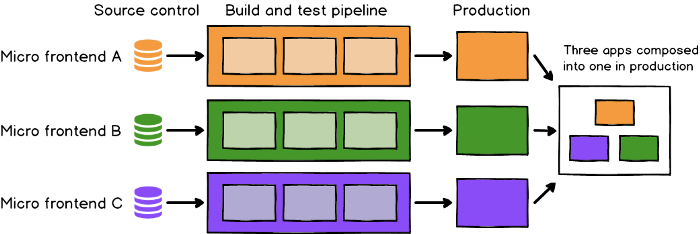
Image source: https://microfrontends.com/
React is a popular frontend tech stack, so it’s a great choice for implementing a micro-frontend. The micro-frontend architecture is still fairly new and being adopted by different frameworks, so best practices are still evolving. Therefore, you may find it challenging to implement a micro-frontend from scratch. Here is where the create-mf-app package comes in.
According to its docs, create-mf-app creates either a module federation application, API server, or library based on one of its templates. It is framework agnostic, meaning it supports multiple frameworks and libraries including Preact, React, and Svelte.
Let’s cover some best practices for you to keep in mind when implementing a micro-frontend architecture.
Each team should develop its features as an independent app, without using a shared state or depending on global variables. Consequently, there should be no sharing of runtime, even if all teams use the same framework.
When isolation is not yet possible, teams should agree on the ownership of namespaces to avoid possible collisions, i.e., CSS, events, local storage, etc.
Each independent team should implement resilient features; even if JavaScript is not enabled or fails, the feature should still work. Additionally, you should foster performance through universal rendering and progressive enhancement.
You should favor browser events for communication instead of building a global pub/sub system; keep cross-team APIs simple.
Simply put, micro-frontends make web applications more maintainable. If you’ve ever been part of building a large application, you know it’s very tedious to manage everything; micro-frontends work similarly to the divide-and-conquer rule.
Now, let’s understand the most valuable benefits of using a micro-frontend.
A significant advantage of the micro-frontend architecture is that you can separate a single body into individual pieces that can be deployed independently. Vercel can support an individual repo with different frontends regardless of the language or framework, deploying them together. Otherwise, you can use deployment services like Netlify. Once the micro-frontend is deployed, you can use it as an individual frontend only.
To secure your micro-frontend, you can use an SSL certificate like Wildcard, a single or multi-domain, or a SAN SSL certificate. One SAN or multi-domain SSL certificate can secure multiple sites and subdomains.
With a micro-frontend architecture, you can combine any language or framework in a single project, like React, Vue, Angular, etc. Each frontend team can independently choose and upgrade its own tech stack without an obligation to coordinate with other teams.
Your team can develop and deploy your frontend whenever you want. There are zero dependencies associated with individual modules, meaning releases can be done quickly. The main goal of defining the micro-frontend is faster iterations.
Each team handles an isolated app feature, which is easier for new developers to understand compared to a frontend monolith. Consequently, the learning curve is linear, translating to lower input costs and higher overall output for new developers.
Before the introduction of micro-frontends, vertical domain ownership was only possible on the backend via the microservices architecture. Companies could scale product development among independent teams to promote ownership of the backend, but, the frontend remained monolithic.
With the introduction of the micro-frontend, the frontend is split into components with vertical domains owned by each team, ranging from the database to the UI.
Micro-frontends foster code reusability because one team can implement and deploy a component that can be reused by multiple teams.
Before jumping into integration testing, it’s better to test individual pieces of an application. Teams will test the micro-frontend before testing the application, thereby decreasing the chances of bugs in the real system.
Apart from that, other advantages include a small codebase that’s easily maintainable and the ability to quickly add or remove any module from the system.
React enables the development of components and also supports a modular approach in web development which is helpful in developing microfrontends. It is compatible with various state management libraries and context providers. This makes React suitable for micro-frontend architectures.
A major advantage of using React is its ecosystem and community support, which offers many libraries and tools that can be integrated into micro-frontends for routing, state management, and UI component libraries, enhancing the development experience.
In this tutorial, we’ll build a micro-frontend with React. To follow along, you’ll need the following:
To follow along with the code, you can check out the GitHub repo for this project.
Create an application folder called micro-frontend-react. To bootstrap a React micro-frontend app, from this folder, run npx create-mf-app and pass the following data to the interactive terminal:
homeApplication3000Select React, JavaScript, and Tailwind as your stack. A React micro-frontend application called home will be bootstrapped for you. In your terminal, you should see the following:

To test the app from the home folder, run yarn install to install all dependencies. Then, run yarn start to start the dev-server. If everything was successful, you should see the following on your screen:
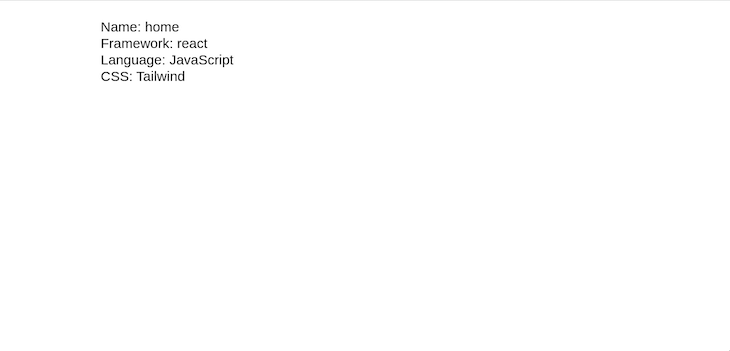
From the about folder, repeat the steps from above using the following data:
aboutApplication3001Like before, select React, JavaScript, and Tailwind as your stack, and the application will be bootstrapped for you.
Finally, to test the app, install the required dependencies by running yarn install. Then, start the dev-server by running yarn start. If everything was successful, you should see the following on your screen:

In our micro-frontend implementation, the home application will contain and expose two components, Header and Footer. The about application imports and consumes these components.
To implement this, in the src directory in the home application, create two components, Header.jsx and Footer.jsx. Add the following respective code snippets to Header.jsx and Footer.jsx:
import React from "react"
export default function Header() {
return (
<div className="p-5 bg-blue-500 text-white -text-3xl font-bold">
Micro Frontend Header
</div>
)
}
import React from "react"
export default function Footer() {
return (
<div className="p-5 bg-blue-500 text-white -text-3xl font-bold">
Micro Frontend Footer
</div>
)
}
Next, update the App.jsx component to use the following navbars:
import React from "react";
import ReactDOM from "react-dom";
import "./index.scss";
import Header from "./Header"
import Footer from "./Footer";
const App = () => (
<div className="text-3xl mx-auto max-w-6xl">
<Header />
<div className="my-10">
Home page Content
</div>
<Footer />
</div>
);
ReactDOM.render(<App />, document.getElementById("app"));
Test the app by restarting the server, and you’ll get the following:
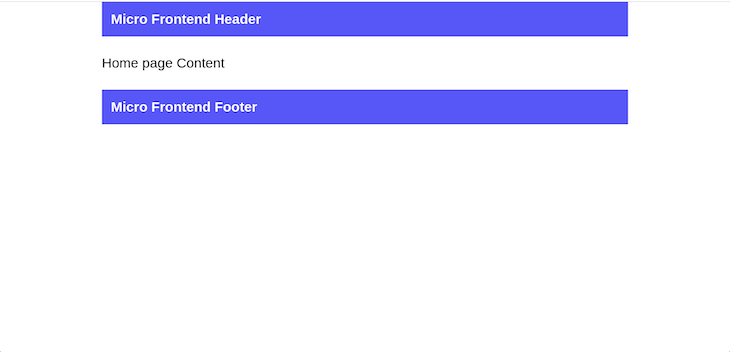
We need to build the about page in the about app. To do so, update the App.jsx component in the about app, as shown below:
import React from "react";
import ReactDOM from "react-dom";
import "./index.scss";
const App = () => (
<div className="text-3xl mx-auto max-w-6xl">
<div class="text-center">
<img
src="https://mdbcdn.b-cdn.net/img/new/avatars/8.webp"
class="rounded-full w-32 mb-4 mx-auto"
alt="Avatar"
/>
<h5 class="text-xl font-medium leading-tight mb-2">John Doe</h5>
<p class="text-gray-500">Web designer</p>
</div>
</div>
);
ReactDOM.render(<App />, document.getElementById("app"));
Restart the dev-server, and you’ll get the following:

From the UI above, we see the need for header and footer navigation. But, we don’t need to create duplicate copies because we can share them via micro-frontends.
We noted above that the about page in the about app needs to consume the Header and Footer components of the home application. To do this, we need to add module federation.
We’ll begin by turning the Header and Footer components of the home application into micro-frontends so that components in other applications can consume them.
Open the webpack.config.js file in the home app, which is already created and configured by the create-mf-app package. First, update the exposes property in the ModuleFederationPlugin configuration, as seen below:
exposes: {
"./Header": "./src/Header.jsx",
"./Footer": "./src/Footer.jsx"
},
In the code above, we specified that the home application exposes the Header and Footer components as micro-frontends. Consequently, these components can be shared.
Now, rebuild and restart the server with the following commands:
yarn build yarn start
Although nothing changes in the UI, a remote entry file has been created for us under the hood. To view the remote entry file, navigate your browser to the URL localhost:3000/remoteEntry.js, and you’ll see the following:
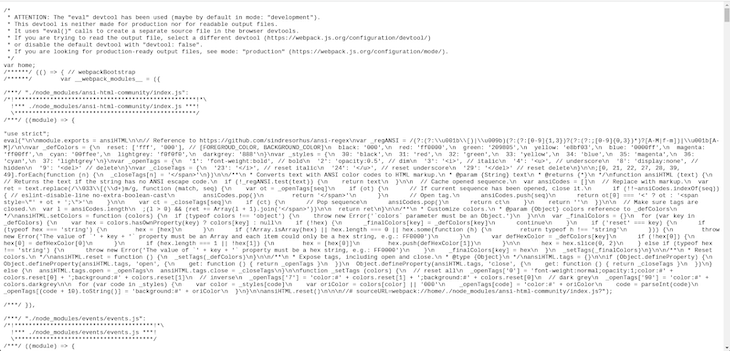
This remote entry file, remoteEntry.js, is a manifest file of all the modules that are exposed by the home application.
To complete our setup, copy the link of the manifest file localhost:3000/remoteEntry.js, then update the remotes property of the ModuleFederationPlugin configuration in the webpack.config.js file in the about app, as seen below:
remotes: {
home: "home@http://localhost:3000/remoteEntry.js",
},
The code above specifies that the about component has a remote micro-frontend application called home that shares its module with it. With this setup, we can access any of the components exposed from the home application.
Now, update the App.jsx component of the about application with the shared navbars, as seen below:
import React from "react";
import ReactDOM from "react-dom";
import "./index.scss";
import Header from "home/Header";
import Footer from "home/Footer";
const App = () => (
<div className="text-3xl mx-auto max-w-6xl">
<Header />
<div class="text-center">
<img
src="https://mdbcdn.b-cdn.net/img/new/avatars/8.webp"
class="rounded-full w-32 mb-4 mx-auto"
alt="Avatar"
/>
<h5 class="text-xl font-medium leading-tight mb-2">John Doe</h5>
<p class="text-gray-500">Web designer</p>
</div>
<Footer />
</div>
);
ReactDOM.render(<App />, document.getElementById("app"));
Now, rebuild and restart the server with the following commands and you’ll see the following in your browser:
yarn build yarn start
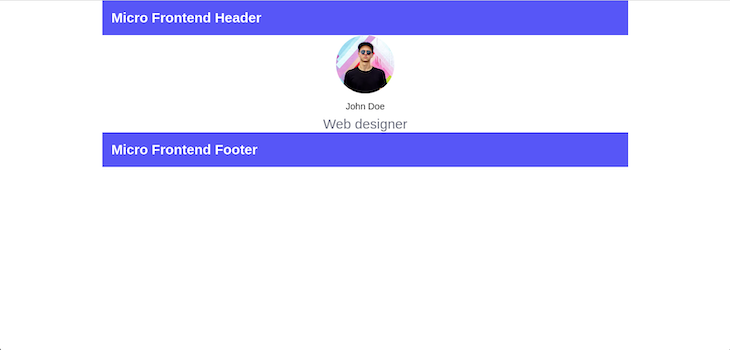
From the code above and the displayed UI, we see that we have successfully shared components between two applications using micro-frontends.
For more information, check out this article about methods for microservice communication.
While building micro-frontends, there are some challenges you might encounter. In this section, you will learn about them and their possible solutions.
Ensuring a consistent styling across different micro-frontends can be tasking especially when they are being developed by different teams. Adopting CSS-in-JS libraries like Styled Components or Emotion in React micro-frontends can encapsulate styles at the component level, avoiding global conflicts.
Managing state across micro-frontends, especially when actions in one micro-frontend need to update the state in another, can complicate state management.
You can handle shared state management libraries like Redux or Zustand with careful namespace management ensures smooth state synchronization. Implementing a global event bus or leveraging the Context API can also enable state sharing and actions across micro-frontends.
Micro-frontends may depend on different versions of libraries or React itself, leading to potential runtime issues or bloated bundle sizes.
webpack’s Module Federation allows you to share libraries across micro-frontends, ensuring that only a single version of React and other shared libraries are loaded.
In this article, we explored the concept of micro-frontends with examples, discussing their advantages over monolithic frontend applications and other available setups. Micro-frontends offer some great features and are easy to adopt.
With create-mf-app, we implemented the micro-frontend architecture as easily as using Create React App. Personally, I like the micro-frontend style because it’s easily maintained among teams. Additionally, frontend building and security are managed pretty elegantly.
I hope you enjoyed this article, and be sure to leave a comment if you have any questions. Happy coding!
Install LogRocket via npm or script tag. LogRocket.init() must be called client-side, not
server-side
$ npm i --save logrocket
// Code:
import LogRocket from 'logrocket';
LogRocket.init('app/id');
// Add to your HTML:
<script src="https://cdn.lr-ingest.com/LogRocket.min.js"></script>
<script>window.LogRocket && window.LogRocket.init('app/id');</script>

Valdi skips the JavaScript runtime by compiling TypeScript to native views. Learn how it compares to React Native’s new architecture and when the trade-off makes sense.

What trends will define web development in 2026? Check out the eight most important trends of the year, from AI-first development to TypeScript’s takeover.

AI-first debugging augments traditional debugging with log clustering, pattern recognition, and faster root cause analysis. Learn where AI helps, where it fails, and how to use it safely in production.

Container queries let components respond to their own layout context instead of the viewport. This article explores how they work and where they fit alongside media queries.
Would you be interested in joining LogRocket's developer community?
Join LogRocket’s Content Advisory Board. You’ll help inform the type of content we create and get access to exclusive meetups, social accreditation, and swag.
Sign up now
43 Replies to "Build a micro-frontend application with React"
Funny that all MFE tutorials out there are in Javascript. Is MFE with Typescript a myth?
Certainly not, TypeScript can be plus on it.
Hi,Does the above solution of using webpack5 module federation plugin also support server side rendering in nextjs.
Yes, it does support SSR.
Well, after reading https://stackoverflow.com/questions/71745780/deployable-mfe-using-nextjs-and-module-federation I was under the impression that SSR is not supported. At least not without buying https://app.privjs.com/buy/packageDetail?pkg=@module-federation/nextjs-ssr for 100$/month. So I am confused. Do you have a source that SSR is really supported?
Good workflow
Thank you!
Hi, do you have a repo with the code? I tried to replicated and lot of errors appeared in different steps.
Hey, here’s the GitHub URL: https://github.com/harshpatel1408/NextJS_microfrontend
Hi,
I did one-to-one what in your tutorial, but I have the error while importing the header component from the fe1 in the fe3 app
ReferenceError: fe1 is not defined
while loading “./header” from webpack/container/reference/fe1
Hi, Try to check if you’re providing right URL for the fe1 in the fe3 app.
I am unable to get this to work. Can you post a repo of the source? Same error as Pawel. while loading “./header” from webpack/container/reference/fe1
Hey, Soon I’ll upload my code to GitHub and then you can try it.
Hey, did you have the time to put this code on a github? I am really needing it to work, BUT, i just cant expose the remoteEntry.js file. Can you help me?
Hey, I’m working on it. Soon it will be on GitHub
Looking forward to check this code, I’m facing the same problem.
Hey, here’s the GitHub URL: https://github.com/harshpatel1408/NextJS_microfrontend
The project has apps as submodules; are you going to put them available too?
Left issues and PR, code would never work if fe2 is called app1.
Can you please upload the working code of the post and some more detailed steps to reproduce the working solution?
Blog post instructions didn’t produce a working project as all the reader comments suggest. Code on GitHub doesn’t work either, so a working code and a list of tested reproducible step would help.
I have updated README.MD file and listed few more steps. Also, posted video for the reference. Code is working as per the function.
Hi Harsh Patel,
Thank you for the step by step tutorial. But unfortunately facing the same issue as Chris and Pawel. while loading “./header” from webpack/container/reference/fe1.
Could you please upload your code to github?
Hey, here’s the GitHub URL: https://github.com/harshpatel1408/NextJS_microfrontend
I’ve read somewhere you would need this plugin @module-federation/nextjs-mf to make things work. Can you relate to this?
It’s not necessary if you’re using webpack 5
I am getting remoteEntry.js 404 not found error, can you help me with this?
Yes sure. I’ll post my code ok GitHub so you can refer that
Hi Harsh,
Thanks for taking the time to create this tutorial. It seems that your repo is out of sync with your post though; It would be super helpful for your readers if you updated the post and also added a little more instruction around how to run the micro frontends in development.
Thanks!
I’m not really sure how you managed to get this to work. I followed your tutorial like many others but was unsuccessful. One thing I came across was the nextjs-mf plugin. On their github page they say that “Module Federation in Next.js depends on @module-federation/nextjs-mf It will not work unless you have access to this plugin, which is not free.” You can see the page here: https://github.com/module-federation/module-federation-examples/tree/master/nextjs. Probably important for anyone trying to follow this tutorial.
For anyone interested, I managed to get a next based mfe setup working and you can see the source here: https://github.com/ChristopherHButler/nextjs-mfe-poc/tree/master/container
It does not support server side rendering because the nextjs-mf plugin is currently not free (they are working to make it free and would appreciate sponsorship! – I am not affiliated with them in any way, just think it is a worthy project). Check the readme for a few extra notes on the repo. Hope this helps someone.
Hey Christoper How did you manage to create remoteEntry.js file for the next app for me build command run completely fine but I cannot see any remoteEntry.js file
it’s defined by Module Federation: https://webpack.js.org/concepts/module-federation/
Hi Christopher, I cloned your repo and am glad to say everything works as stated on the README. However, I would like to expose a NextJS remote entry to another NextJs consumer app. I’ve been able to create the remoteEntry.js file with the build command but I’ve not been able to access the file on the browser and on the consumer app.
I have achieved it using Webpack 5 module-federation. I need to check @module-federation/nextjs-mf plugin. If It works with that plugin I’ll update my code based on it. I’ll definitely explore that package soon and see if there’s any workaround for free or need to use paid only. Also, need to check for Next.JS version compatibility.
Great post. One short question. Why do you have to add the script tags for the remote entries in _document.js and also add the references in the next.config.js?
Hey, it’s not necessary to add it in _document.js as you are already setting it up in next.config.js. I have added it to just check whether it works that way or not. Definitely we can omit it.
Tried w/ github code but lots of errors. The readme should be more explicit if this should in fact work
Hey, thanks for the amazing tutorial. GitHub code is very helpful to me.
Hi Harsh,
I am getting error on below line while consuming remote app.
https://github.com/ChristopherHButler/nextjs-mfe-poc/tree/master/container
const Header = React.lazy( () => import(‘fe1/header’));
const squareRoot = React.lazy( () => import(‘fe2/getSquareRoot’));
Please suggest.
Note: I am doing configuration in next.config.js only (for expose and remote).
Thanks,
Bhavik
Been looking for a MF tutorial and found this one to be absolutely easy and useful, Thanks alot Mate.
Did anybody tried to build? In my case, build file only runs if project is running. Am I missing anything? Thanks alot.
I have tried the example given in the blog, in the about us page I am not seeing the styling of header and footer. it is just displaying plain text no background color and other style.
Hello! We checked with the author, and there was one command missing:`yarn build`. Take a look at those two sections, and you should be all set!
Try adding this line on Header.jsx and Footer.jsx.
import “./index.scss”;